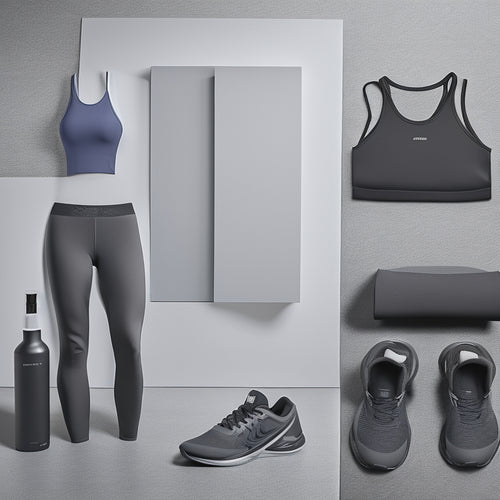
7 Warm-Up Secrets for Stunning Middle Eastern Moves
Share
Imagine watching a mesmerizing Middle Eastern dance performance, where the dancer's hips sway effortlessly and her movements seem almost supernatural. You've probably wondered how they achieve such fluidity and control. The secret lies in their warm-up routine. By incorporating specific exercises, you can access your full potential and execute intricate movements with precision and grace. But what are these secret warm-up exercises, and how can you incorporate them into your practice?
Key Takeaways
• Unlock flexibility in the hips with exercises like Hip Circles and Pelvic Tilts to achieve fluid movements.
• Engage core strength quickly through Abdominal Contractions and a neutral spine for posture and power.
• Mobilize shoulder blades with scapular exercises, shoulder rolls, and blade circles for stabilized arms.
• Prepare the spine for movement with chest opens, spinal rolls, cat-cow stretch, and neck stretches for flexibility and posture.
• Activate lower body muscles, including the core, pelvic floor, glutes, and ankle mobility, for safe and effective footwork execution.
Unlocking Flexibility in the Hips
As you get ready to commence your Middle Eastern dance journey, freeing up flexibility in your hips is essential, since this region is central to the fluid, sinuous movements that define this enchanting style.
You'll want to focus on exercises that target the hip joint, allowing you to move with grace and fluidity. One effective exercise is Hip Circles, which involve moving your hips in a large, circular motion. Start by standing with your feet shoulder-width apart, then move your hips in a circle, first clockwise and then counterclockwise. Repeat this motion several times to release tension in your hip joint.
Another essential exercise for hip flexibility is Pelvic Tilts. To do this exercise, stand with your feet shoulder-width apart and your hands on your hips. Tilt your pelvis upwards and then back down again, repeating the motion several times. This exercise helps to release tightness in the muscles in your lower back and hips, allowing for greater flexibility and movement.
Activating Core Strength Quickly
You'll need to engage your core muscles to maintain good posture and generate power for the dynamic movements in Middle Eastern dance, so let's get them fired up quickly. Your core, including your abs, obliques, and lower back, is the foundation of your dance. To activate your core strength, start by finding a neutral spine position. Imagine a string pulling your belly button towards your spine, and then engage your abdominal muscles by drawing your belly button inwards. This is called an Abdominal Contraction.
| Action | Muscles Engaged | Benefits |
|---|---|---|
| Pelvic Tilt | Lower Abs, Lower Back | Improves Posture, Reduces Back Pain |
| Abdominal Contraction | Transverse Abdominis, Obliques | Increases Core Strength, Stabilizes Spine |
| Neutral Spine | Entire Core | Maintains Good Posture, Generates Power |
As you practice these exercises, focus on slow, controlled movements, and avoid holding your breath. Remember to breathe naturally and smoothly, and don't sacrifice proper form for speed. By incorporating these exercises into your warm-up routine, you'll be well on your way to activating your core strength quickly and safely.
Warming Up the Shoulder Blades
Your shoulder blades, or scapulae, play an essential role in stabilizing your arms and generating power for expressive Middle Eastern dance movements, so it's important to warm them up properly. As you prepare for a stunning dance performance, don't neglect this significant step.
To begin, stand or sit comfortably with your arms relaxed by your sides. Engage in some gentle scapular mobilization exercises to loosen up your shoulder blades.
Roll your shoulders forward and backward in a circular motion, repeating this process several times.
Next, focus on blade circles. Slowly lift your shoulder blades, squeezing them together, and then release. Repeat this action several times, gradually increasing your pace as you become more comfortable.
Remember to breathe naturally and avoid tensing up, as this can put unnecessary strain on your shoulders. By incorporating these simple exercises into your warm-up routine, you'll be well-prepared for the dynamic movements that Middle Eastern dance has to offer.
Preparing the Spine for Movement
Now that your shoulder blades are warm and ready, focus on preparing your spine for the dynamic movements ahead, starting with some gentle chest opens to loosen up your thoracic region. This will improve your Spinal Awareness and set you up for success.
Next, practice Vertebral Relaxation by imagining a string gently pulling your head up towards the ceiling. Feel the length and relaxation spread through your spine as you inhale. As you exhale, allow your vertebrae to settle and relax, releasing any tension or stress.
Here are some exercises to help you prepare your spine for movement:
| Exercise | Description | Benefits |
|---|---|---|
| Chest Opens | Stand with arms extended out to the sides, then squeeze shoulder blades together and open chest. | Improves posture, reduces tension |
| Spinal Rolls | Slowly roll your spine from top to bottom, focusing on relaxation. | Reduces stress, improves flexibility |
| Cat-Cow Stretch | Alternate between arching and rounding your back, focusing on spine flexibility. | Improves flexibility, reduces stiffness |
| Neck Stretch | Slowly tilt your head to the side, bringing ear towards shoulder. | Reduces tension, improves range of motion |
Remember to breathe deeply and slowly, focusing on relaxation and Spinal Awareness. By preparing your spine for movement, you'll set yourself up for success and reduce your risk of injury.
Engaging the Lower Body Muscles
As you prepare to move into more dynamic Middle Eastern movements, engage your lower body muscles by activating your core and pelvic floor, which will help stabilize your body and generate power. This foundation is essential for executing complex movements safely and effectively.
Next, focus on ankle mobility exercises to improve your range of motion and prevent injuries. Perform calf stretches to loosen tight muscles and enhance flexibility. Don't forget to activate your glutes, the powerhouse of your lower body, to generate strength and stability.
Remember to prioritize knee stability exercises to protect your joints from excessive strain. By engaging your lower body muscles, you'll be better equipped to execute intricate footwork, rapid weight transfers, and dynamic movements characteristic of Middle Eastern dance.
A strong, stable lower body won't only enhance your overall performance but also reduce your risk of injury. By incorporating these exercises into your warm-up routine, you'll be well-prepared to tackle even the most challenging movements with confidence and poise.
Effective Neck and Arm Warm-Ups
With a strong lower body foundation in place, you're ready to focus on mobilizing your upper body, starting with effective neck and arm warm-ups that will prepare you for the intricate, expressive movements characteristic of Middle Eastern dance.
To begin, gently tilt your head to the right, bringing your ear towards your right shoulder. Hold for a few seconds, then slowly return to center. Repeat on the left side. This simple movement helps loosen the neck muscles, easing any tension that may be present.
Next, perform Neck Circles by slowly rotating your head in a circular motion, first clockwise and then counterclockwise. Be gentle and controlled, avoiding any jerky movements that may cause strain.
Moving on to your arms, perform Arm Waves by holding your arms straight out to the sides at shoulder height. Gently wave your arms up and down, keeping your shoulders relaxed and down. This helps increase blood flow and flexibility in your shoulders and arms, preparing them for the dynamic movements to come.
Remember to breathe naturally and smoothly, avoiding any bouncing or forcing of your joints. By incorporating these simple yet effective warm-ups into your routine, you'll be well-prepared to tackle the beautiful, flowing movements of Middle Eastern dance.
Boosting Energy With Breathing Exercises
As you prepare to boost your energy with breathing exercises, you'll want to focus on two key techniques that will get you moving.
You'll learn how to harness the power of cleansing breaths to clear your mind and body, and discover energizing diaphragm exercises that will leave you feeling invigorated.
Cleansing Breath Techniques
You'll elevate your energy levels by mastering the ancient art of cleansing breath techniques, a fundamental component of Middle Eastern dance preparation. As you start on this journey, remember that breathing isn't just about inhaling and exhaling; it's an art that requires mindfulness and intention. By incorporating cleansing breath techniques into your daily routine, you'll experience a profound impact on your overall energy and well-being.
Here are some essential tips to get you started:
-
Morning Rituals: Begin your day with 5-10 minutes of conscious breathing, focusing on slow, mindful exhales.
-
Mindful Exhales: Release tension and stress by exhaling slowly through your mouth, allowing your diaphragm to drop and your belly to rise.
-
Box Breathing: Inhale for a count of 4, hold for a count of 4, exhale for a count of 4, and hold again for a count of 4.
-
4-7-8 Breathing: Inhale through your nose for a count of 4, hold for a count of 7, and exhale through your mouth for a count of 8.
-
Progressive Muscle Relaxation: Breathe in deeply, then exhale while tensing and relaxing different muscle groups in your body.
Energizing Diaphragm Exercises
By engaging your diaphragm, the primary muscle responsible for breathing, you can tap into a potent energy source that will leave you feeling revitalized and refreshed. As you prepare for your Middle Eastern dance routine, incorporating diaphragm exercises into your warm-up can make a significant difference.
Begin by lying on your back, placing one hand on your abdomen and the other on your chest. Inhale deeply through your nose, allowing your diaphragm to drop and your belly to rise as your lungs fill with air. Your chest shouldn't move; instead, focus on expanding your ribcage, promoting Rib Expansion. This will help you engage your diaphragm, maximizing oxygen intake.
Next, sit up and practice Chest Openers. Place your hands behind you, interlocking your fingers, and gently stretch your chest forward. This will help increase oxygen flow and further engage your diaphragm.
Repeat these exercises several times, feeling your energy levels rise as your diaphragm strengthens.
Frequently Asked Questions
Can I Still Warm up if I Have a Prior Injury or Chronic Pain?
Like a careful architect designing a sturdy bridge, you can safely warm up despite prior injuries or chronic pain by modifying exercises to suit your needs and incorporating gentle stretching to avoid exacerbating the issue.
How Long Should My Warm-Up Routine Take Each Day?
You should aim for a 10-15 minute warm-up routine each day, focusing on morning consistency to boost daily flexibility and safely prepare your body for physical activity, even with prior injuries or chronic pain.
Can I Warm up at Home Without Special Equipment or a Gym?
You can definitely warm up at home without special equipment or a gym; start your morning routine with a 10-minute Home Stretch, incorporating gentle movements to loosen your muscles, and you're ready to go!
Are There Any Specific Warm-Ups for Beginners or Older Adults?
As a beginner or older adult, you'll benefit from gentle stretching exercises that prioritize flexibility focus, such as neck rolls, shoulder opens, and hip circles, which improve range of motion and reduce injury risk.
Can I Still Warm up Effectively if I'm Short on Time?
As you rush to get ready in the morning, you wonder if you can still warm up effectively in a pinch. The answer is yes! A quick 5-minute dynamic stretch or jumping jacks can be a time-saving quick fix for your morning rush.
Related Posts
-

Group Dance Makeup Tutorials for Online Success
As you immerse yourself in the world of group dance makeup tutorials, you'll need to master essential makeup techniqu...
-

10 Online Makeup Tutorials for Ballet Dancers
You're about to discover a range of makeup techniques specifically designed to enhance your ballet performances, from...
-

What Are the Essential Performance Clothing Items for Your Next Workout
When it comes to crushing your next workout, the right performance clothing can make all the difference. You'll want ...


